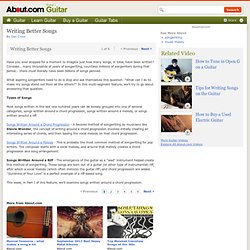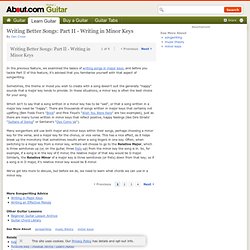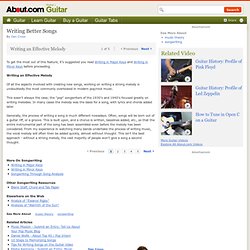

Music Theory. Writing Better Songs - Part I. Have you ever stopped for a moment to imagine just how many songs, in total, have been written?

Consider... many thousands of years of songwriting, countless millions of songwriters during that period... there must literally have been billions of songs penned. What aspiring songwriters need to do is stop and ask themselves this question: "What can I do to make my songs stand out from all the others? " In this multi-segment feature, we'll try to go about answering that question. Types of Songs Most songs written in the last one hundred years can be loosely grouped into one of several categories; songs written around a chord progression, songs written around a melody, or songs written around a riff.
Songs Written Around a Chord Progression - A favored method of songwriting by musicians like Stevie Wonder, the concept of writing around a chord progression involves initially creating an interesting series of chords, and then basing the vocal melody on that chord progression. Writing Better Songs: Part II - Writing in Minor Keys. In the previous feature, we examined the basics of writing songs in major keys, and before you tackle Part II of this feature, it's advised that you familiarize yourself with that aspect of songwriting.

Sometimes, the theme or mood you wish to create with a song doesn't suit the generally "happy" sounds that a major key tends to provide. In these situations, a minor key is often the best choice for your song. Which isn't to say that a song written in a minor key has to be "sad", or that a song written in a major key need be "happy". There are thousands of songs written in major keys that certainly not uplifting (Ben Folds Five's "Brick" and Pink Floyd's "Wish You Were Here" are two examples), just as there are many tunes written in minor keys that reflect positive, happy feelings (like Dire Straits' "Sultans of Swing" or Santana's "Oye Como Va").
We've got lots more to discuss, but before we do, we need to learn what chords we can use in a minor key. Writing Better Songs - Part III - Writing an Effective Melody. To get the most out of this feature, it's suggested you read Writing in Major Keys and Writing in Minor Keys before proceeding.

Writing an Effective Melody Of all the aspects involved with creating new songs, working on writing a strong melody is undoubtedly the most commonly overlooked in modern pop/rock music. This wasn't always the case; the "pop" songwriters of the 1930's and 1940's focused greatly on writing melodies. In many cases the melody was the basis for a song, with lyrics and chords added later. Generally, the process of writing a song is much different nowadays. Shortcuts to Hit Songwriting. This easy-to-use guide will show you how to write a song, from finding a great title to writing your melody.

Hands-on songwriting exercises will jump start your creativity, while ‘how-to’ video tutorials are a fun way to find out more. by Robin Frederick. Request permission to reprint What comes first, melody or lyrics? How does an idea become a whole song? If a song genuinely expresses your feelings, then it’s a good song. So, how do you write a song that moves other people and makes them want to listen?
‣ What is song craft and why do I need it??? Good songwriters use song craft to give their songs emotional impact and create a memorable experience for listeners. The simple, time-tested ideas on this page will help you create a song that expresses your feelings and moves listeners, keeping them involved and interested in what you have to say. . ‣ How does a song get started? Getting started can be one of the hardest tasks in songwriting. So which comes first – lyrics, melody, or chords?